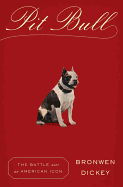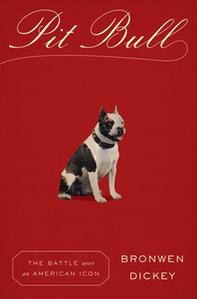
 Seven years ago, North Carolina essayist and journalist Bronwen Dickey (yes, that Bronwen, of her father James Dickey's poem "Bronwen, the Traw, and the Shape-shifter") rescued a pit bull mix for a family dog. Friends and neighbors rolled their eyes and advised caution, believing the hype that pit bulls have "a long legacy of human bloodlust and betrayal, hard-line genetic determinism, and unprovoked animal rage." Dickey, however, was won over by Nola's eyes--"It was a look with layers." Curious, she set out to study the history, genetics and mythology of this much-maligned bulldog derivative--a canine that the American Kennel Club doesn't even officially recognize as a separate breed. What Mary Roach did for the alimentary canal (Gulp), Marc Levinson did for the shipping container (The Box) and, more recently, Aja Raden did for the gemstone (Stoned), Dickey has done for the pit bull. Judiciously filled with data, anecdotes, illustrations and a self-deprecating, canny sense of humor, Pit Bull is a constantly surprising compendium of dog lore, human foible and social prejudice.
Seven years ago, North Carolina essayist and journalist Bronwen Dickey (yes, that Bronwen, of her father James Dickey's poem "Bronwen, the Traw, and the Shape-shifter") rescued a pit bull mix for a family dog. Friends and neighbors rolled their eyes and advised caution, believing the hype that pit bulls have "a long legacy of human bloodlust and betrayal, hard-line genetic determinism, and unprovoked animal rage." Dickey, however, was won over by Nola's eyes--"It was a look with layers." Curious, she set out to study the history, genetics and mythology of this much-maligned bulldog derivative--a canine that the American Kennel Club doesn't even officially recognize as a separate breed. What Mary Roach did for the alimentary canal (Gulp), Marc Levinson did for the shipping container (The Box) and, more recently, Aja Raden did for the gemstone (Stoned), Dickey has done for the pit bull. Judiciously filled with data, anecdotes, illustrations and a self-deprecating, canny sense of humor, Pit Bull is a constantly surprising compendium of dog lore, human foible and social prejudice.
In her search of official kennel club records, newspaper history and even the advertising and film industry, Dickey traces the American pit bull terrier to the infamous lower Manhattan Five Points dog fighting pits. There, the English bulldog (named for the medieval practice of bullbaiting in order to "worry" an old tethered bull and naturally tenderize its meat) was crossbred with the terrier into a "Nietzchean Überhund." From there, the bull class of dogs rose in the 1920s to be "seen as quintessentially American: good-natured, brave, resilient, and dependable"--even appearing in 224 Pal the Wonder Dog movies (Rin Tin Tin starred in only 27) and earning the nickname "nanny dog" for its role in guarding children. By the 1950s, the rising middle class with big suburban yards turned dog breeds into brands, "almost as if they were new cars," which "followed 'boom-and-bust' cycles... [like] clothing styles and baby names." Collies jumped in popularity with the Lassie TV shows, and Labrador fans grew in the '80s with the Clintons' Buddy and Seamus, but urban gang association rapidly sent regard for the bull terrier downhill. Today pit bulls are banned in 850 U.S. communities and the entire United Kingdom. As Dickey paraphrases them, stereotypes abound: "pit bulls are not for people like 'us'--the respectable and morally upstanding members of society; pit bulls belong to them."
Exploring the history and politics behind the pit bull's current bad rep, Dickey interviews trainers (like breed-loyal Diane Jessup who scowls: "I refuse to face an uncertain future with a f*cking Labradoodle") and taps "news stories" about drug dealers, violent dog attacks on children, unscrupulous puppy mills, the infamous pro football star Michael Vick's fighting dog abuse arrest, and even the symbolism of some Ferguson protestors leading pit bulls in the Michael Brown demonstrations. Of the 77 million domestic dogs in the United States, pit bulls are a tiny fraction. As Dickey clearly and absorbingly illustrates, pit bulls are not evil incarnate--they "are not dangerous or safe... aren't saints or sinners.... Pit bulls are just... dogs." --Bruce Jacobs, founding partner, Watermark Books & Cafe, Wichita, Kan.
Shelf Talker: The much-maligned pit bull finds redemption in Bronwen Dickey's entertaining, thoughtful and well-researched study of this noble canine.

